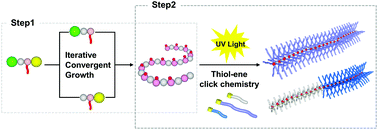Synthesis of discrete bottlebrush polymers via the iterative convergent growth technique and post-functionalization†
Abstract
Bottlebrush polymers (BBPs) have unique physical properties that arise from polymeric side chains that are densely grafted onto their polymer backbone. Despite their promising attributes, well-defined BBPs are challenging to prepare partly due to steric hindrance encountered during macromonomer polymerization or during the coupling of side-chain polymers with functional groups present in the repeating units of the backbone polymers. Here we report the synthesis of perfectly discrete BBPs with absolutely defined chemical structures. The copolyester backbone, composed of up to 64 repeating units of an alternating sequence of lactic acid and 2-hydroxy-4-pentenoic acid, was synthesized using an iterative convergent growth technique. Discrete side chains, such as discrete polylactides (LAn-SH), were introduced in the presence of the vinyl groups of the 2-hydroxy-4-pentenoic acid residues on the copolyester backbone using thiol–ene click chemistry promoted by UV light (λ = 365 nm), which produced a fully grafted BBP, t-LP(LA8)32-LA8 (Molecular weight (MW = 34 kDa). We also synthesized an amphiphilic bottlebrush block copolymer (BBCP) (MW = 19 kDa) by introducing the hydrophobic dodecanethiol and discrete poly(ethylene glycol) as side chains. The resulting BBCP self-assembled into well-defined micelles in water. Discrete BBCPs may serve as model systems that help to elucidate the role of the branched architecture on the physical and chemical behavior of BBCPs in bulk and solution.



 Please wait while we load your content...
Please wait while we load your content...